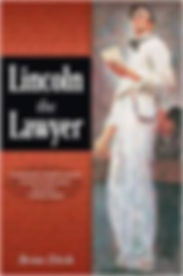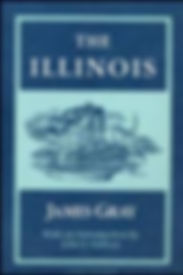Corn Kings and One-Horse Thieves
Odds & ends

Illinois past and present, as seen by James Krohe Jr.
The Corn Latitudes
A Poor Piece of Work
Tidying up the Lincoln home area by paving it
Illinois Times
June 10, 1977
The City of Springfield has, in general, been a poor steward of the Abraham Lincoln house neighborhood. That record had much to do with the decision in the 1970s to hand over the house lot and four surrounding city blocks to the National Park Service to protect it from creeping blight and garish commercial development. One understands why when considering this proposal to establish an historic district on land abutting the NPS site.
Note that the handsome Graham House mentioned below has survived, but three of the buildings in that block of Seventh Street, including the Prince Sanitarium, have been destroyed for parking.
There is presently threading its way through the city's bureaucratic maze a proposed ordinance calling for an amendment to Article XV, Chapter 49 of the Springfield City Code. The amendment would establish an historical district along the west side of South Seventh Street between Capitol and Edwards, similar to the historical districts which now control development in the neighborhoods of Lincoln's home and the governor's mansion. The ordinance was prepared after much discussion by the fifteen men and women of the Springfield Historical Sites Commission. It reveals much about why historic preservation is in such a parlous state in the Capital City, and for that reason deserves a closer look.
The major provisions of the ordinance are straightforward enough. The amendment it proposes is intended to insure that "development of the property directly fronting the . . . Lincoln Visitors" Center will not be incompatible with the historic heritage of the area." This will be done by requiring that "the exterior design of the buildings in the district will be in harmony with the historic shrines" in the neighborhood. The amendment establishes specific design standards governing building height, setback requirements, sign size and placement, landscaping and so on.
The goal is laudable. The amendment itself, alas, is not. Consider if you will Sec. 49.15.17, which sets height limits for buildings within the district. Early drafts of the proposal included a fifty-foot ceiling on buildings (roughly five stories). The fifty-foot limit did not, however, survive the City council. When the amendment was circulated among the council members informally a few weeks ago, they—not wishing to handcuff the movers and shakers who might want to develop property in the district—said they would approve the measure only if the height limit was raised to 250 feet. The HSC obligingly agreed to the revision on a vote of nine to four—this in spite of the fact that it would be impossible to build any twenty-five story building which by its nature is not, in the words of the amendment, "obviously incongruous with the Lincoln Home National Historic Site."
Nearly as vexing was the issue of allowable uses. Originally the commission had considered adopting the relatively modest list of uses now allowed in the city's two existing historical districts. But several members argued that this, too, would make for a not-quite-free-enough brand of free enterprise. So the commission appropriated (with some deletions, such as taxidermists, taxi stands, and physical culture studios) the more generous list of uses allowed under S-3, or commercial, zoning. The resulting list sanctions no fewer than fifty-two different uses. They range from churches and private residences to hardware stores, brokerage houses, department stores, hotels and motels, commercial museums, taverns, and parking facilities. Massage parlors are frowned on, as are-drive-ins, but just about anything else goes.
It is curious, though considering the commission's record not surprising, that there is not a single word in the four-page proposal about actually preserving any of the buildings now standing in the district. They include the Prince Sanitarium and the 115-year-old Graham house three doors to the south, plus several other structures which, though of more recent vintage, share a common scale. Together they give these two blocks an intimacy and sense of proportion rare in Springfield. That kind of environment is worth saving, and no amount of landscaping, no amount of sign control could restore what a twenty-five story hotel or a parking ramp would destroy.
The provisions of the amendment controlling signs, setbacks, and landscaping are badly needed (and not just in historical districts) and I for one will be glad to see them added to the code. But on the whole the amendment as proposed is a failure. It does nothing significant to insure that development in the area will be "in harmony with the historic shrines in the district." It betrays a pro-development bias more seemly in a chamber of commerce than in an historical sites commission. And it fails even to address the issue of preservation in one of the center city's more preservable blocks.
To their credit, a few commission members have fought against the weakening of the amendment by their fellow commissioners and the city council. (It was the council, led by the mayor, that raised the height limit to 250 feet. They also fretted over possible objections by property owners. So, showing the solicitousness that surfaces whenever tax money is at stake, they ordered that copies of the draft be circulated among the owners for comment.)
Between them, the council and the commission that advises them have done a poor piece of work one that tells us everything we need to know about the Historical Sites Commission. ●
SITES
OF
INTEREST
Essential for anyone interested in Illinois history and literature. Hallwas deservedly won the 2018 Lifetime Achievement Award from the Illinois State Historical Society.
One of Illinois’s best, and least-known, writers of his generation. Take note in particular of The Distancers and Road to Nowhere.
See Home Page/Learn/
Resources for a marvelous building database, architecture dictionary, even a city planning graphic novel. Handsome, useful—every Illinois culture website should be so good.
The online version of The Encyclopedia of Chicago. Crammed with thousands of topic entries, biographical sketches, maps and images, it is a reference work unmatched in Illinois.
The Illinois chapter of the American Institute of Architects in 2018 selected 200 Great Places in Illinois that illustrate our shared architectural culture across the entire period of human settlement in Illinois.
A nationally accredited, award-winning project of the McLean County Historical Society whose holdings include more than 20,000 objects, more than 15,000 books on local history and genealogy, and boxes and boxes of historical papers and images.
Mr. Lincoln, Route 66, and Other Highlights of Lincoln, Illinois
Every Illinois town ought to have a chronicler like D. Leigh Henson, Ph.D. Not only Lincoln and the Mother road—the author’s curiosity ranges from cattle baron John Dean Gillett to novelist William Maxwell. An Illinois State Historical Society "Best Web Site of the Year."
Created in 2000, the IDA is a repository for the digital collections of the Illinois State Library and other Illinois libraries and cultural institutions. The holdings include photographs, slides, and glass negatives, oral histories, newspapers, maps, and documents from manuscripts and letters to postcards, posters, and videos.
The people's museum is a treasure house of science and the arts. A research institution of national reputation, the museum maintains four facilities across the state. Their collections in anthropology, fine and decorative arts, botany, zoology, geology, and history are described here. A few museum publications can be obtained here.
“Chronicling Illinois” showcases some of the collections—mostly some 6,000 photographs—from the Illinois history holdings of the Abraham Lincoln Presidential Library.
I will leave it to the authors of this interesting site to describe it. "Chicagology is a study of Chicago history with a focus on the period prior to the Second World War. The purpose of the site is to document common and not so common stories about the City of Chicago as they are discovered."
Illinois Labor History Society
The Illinois Labor History Society seeks to encourage the preservation and study of labor history materials of the Illinois region, and to arouse public interest in the profound significance of the past to the present. Offers books reviews, podcasts, research guides, and the like.
Illinois Migration History 1850-2017
The University of Washington’s America’s Great Migrations Project has compiled migration histories (mostly from the published and unpublished work by UW Professor of History James Gregory) for several states, including Illinois. The site also includes maps and charts and essays about the Great Migration of African Americans to the north, in which Illinois figured importantly.
An interesting resource about the history of one of Illinois’s more interesting places, the Fox Valley of Kendall County. History on the Fox is the work of Roger Matile, an amateur historian of the best sort. Matile’s site is a couple of cuts above the typical buff’s blog. (An entry on the French attempt to cash in on the trade in bison pelts runs more than
2,000 words.)
BOOKS
OF INTEREST

Southern Illinois University Press 2017
A work of solid history, entertainingly told.
Michael Burlingame,
author of Abraham
Lincoln: A Life
One of the ten best books on Illinois history I have read in a decade.
Superior Achievement Award citation, ISHS Awards, 2018
A lively and engaging study . . . an enthralling narrative.
James Edstrom
The Annals of Iowa
A book that merits the attention of all Illinois historians
as well as local historians generally.
John Hoffman
Journal of Illinois HIstory
A model for the kind of detailed and honest history other states and regions could use.
Harold Henderson
Midwestern Microhistory
A fine example of a resurgence of Midwest historical scholarship.
Greg Hall
Journal of the Illinois
State Historical Society
Click here
to buy the book
Southern Illinois University Press
SIU Press is one of the four major university publishing houses in Illinois. Its catalog offers much of local interest, including biographies of Illinois political figures, the history (human and natural) and folklore of southern Illinois, the Civil War and Lincoln, and quality reprints in the Shawnee Classics series.
The U of I Press was founded in 1918. A search of the online catalog (Books/Browse by subject/Illinois) will reveal more than 150 Illinois titles, books on history mostly but also butteflies, nature , painting, poetry and fiction, and more. Of particular note are its Prairie State Books, quality new paperback editions of worthy titles about all parts of Illinois, augmented with scholarly introductions.
The U of C publishing operation is the oldest (1891) and largest university press in Illinois. Its reach is international, but it has not neglected its own neighborhood. Any good Illinois library will include dozens of titles about Chicago and Illinois from Fort Dearborn to
Vivian Maier.
Northern Illinois University Press
The newest (1965) and the smallest of the university presses with an interest in Illinois, Northern Illinois University Press gave us important titles such as the standard one-volume history of the state (Biles' Illinois:
A History of the Land and Its People) and contributions to the history of Chicago, Illinois transportation, and the Civil War. Now an imprint of Cornell University Press.




Reviews and significant mentions by James Krohe Jr. of more than 50 Illinois books, arranged in alphabetical order
by book title.
Run by the Illinois State Library, The Center promotes reading, writing and author programs meant to honor the state's rich literary heritage. An affiliate of the Library of Congress’s Center for the Book, the site offers award competitions, a directory of Illinois authors, literary landmarks, and reading programs.
